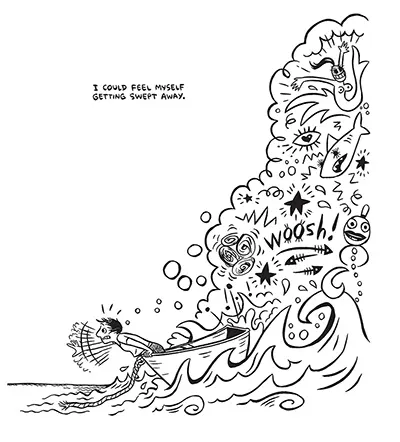Bipolar Disorder: Mania

Prov 23:33 NIV - Your eyes will see strange sights, and your mind will imagine confusing things.
Since bipolar disorder consists of alternating states of mania vs. depression, I've included a webpage about each. Mania is a disordered illogical thought process that occurs in bipolar disorder, schizonphrenia, and several other mental illnesses. The cartoon to the left was drawn by Ellen Forney, an artist with bipolar disorder who used her graphic skills to describe what a "wave" of mania feels like. The symptoms of mania are variable in type intensity and include:
- Disturbed or illogical thinking
- Very happy, elated, or overjoyed
- Talking very quickly
- Unusually full of energy
- Feeling self-important
- Full of great new ideas and important plans
- Easily distracted
- Easily irritated or agitated
- Delusions or hallucinations
People in a manic state may have difficulty filtering out meaningful from non-meaningful input and may thus respond to their environment in surprising ways. When this happens, ordinary sensory input, such as the sound of traffic or blinking lights, may become severely distracting. As a result, people experiencing mania focus attention on nonessential information.
Observable Changes in Brain Activity: Evidence from functional neuroimaging studies suggest that during mania there is a reduced activity of right ventromedial and ventrolateral prefrontal cortices and an increased activity of left amygdala, left anterior cingulate cortex, and left basal ganglia. In plain language, this means that during manic episodes rational thought is eclipsed by emotion . Researchers also report that manic episodes lead to decreased volume in certain areas of the brain.
Flight of Ideas: This symptom involves rapid, erratic speech that switches quickly from one topic to the next. The thoughts often involve grandiose delusions. A friend of mine always wanted to talk about how he was going to fix the world when I wanted him to talk about how he was going to fix himself.
Tangentiality: refers to a disturbance in the thought process that causes the individual to relate excessive or irrelevant detail that never reaches the essential point of a conversation or the desired answer to a question. Stated differently, their thoughts head off on a tangent and never return.
Circumstantiality: Circumstantiality contains tighter and more coherent associations between thoughts that may be easier to follow or understand. Unlike tangential speakers, circumstantial speakers eventually return to the main point or the answer the original question. They just take an unusually circuitous path to get there.
Derailment: A person with derailment talks in chains of only semi-related ideas. Their ideas often jump further and further from the topic of conversation. For example, a person with derailment thought disorder might jump from talking about rabbits to the hair on their head and then to your sweater.
Anger: Mania tends to trigger aggressive emotions and anger. Racing thoughts and high energy levels can leave a person feeling angry, irritable, and frustrated. Those angry emotions, in turn, can cause aggressive and inappropriate behaviors.
How to Respond to a Manic Person:
- Recognize what is going on and remember that you have no power to fix it. It's not going to respond to reason.
- Express empathy and compassion.
- Encourage your loved one to talk to you, and listen to what they have to say.
- Avoid intense conversations or arguments. Don't challenge their thoughts or feelings.
- Answer questions honestly and succinctly. But don't allow yourself to be drawn into an argument or debate.
- After a reasonable amount of time, gracefully end the conversation. A manic person can talk forever!